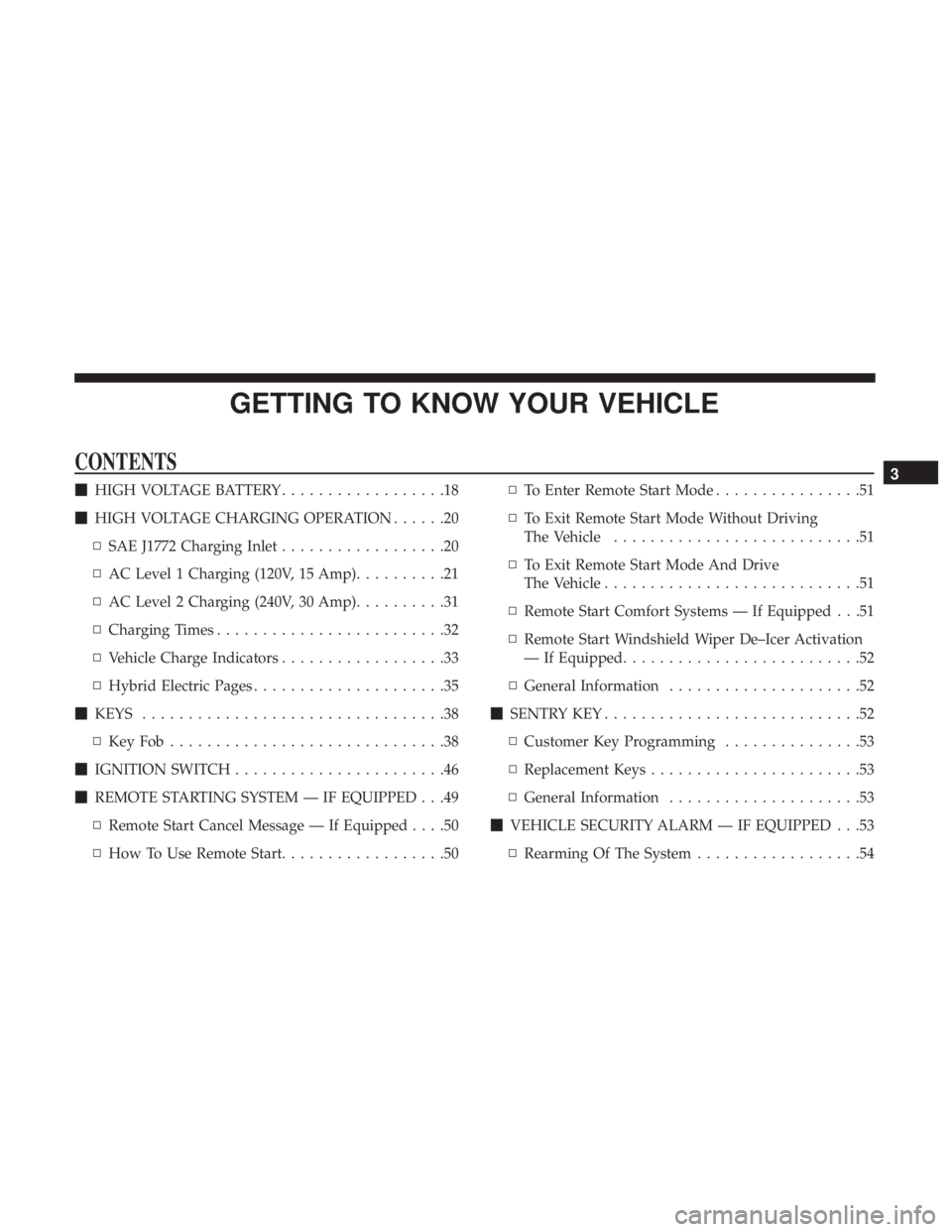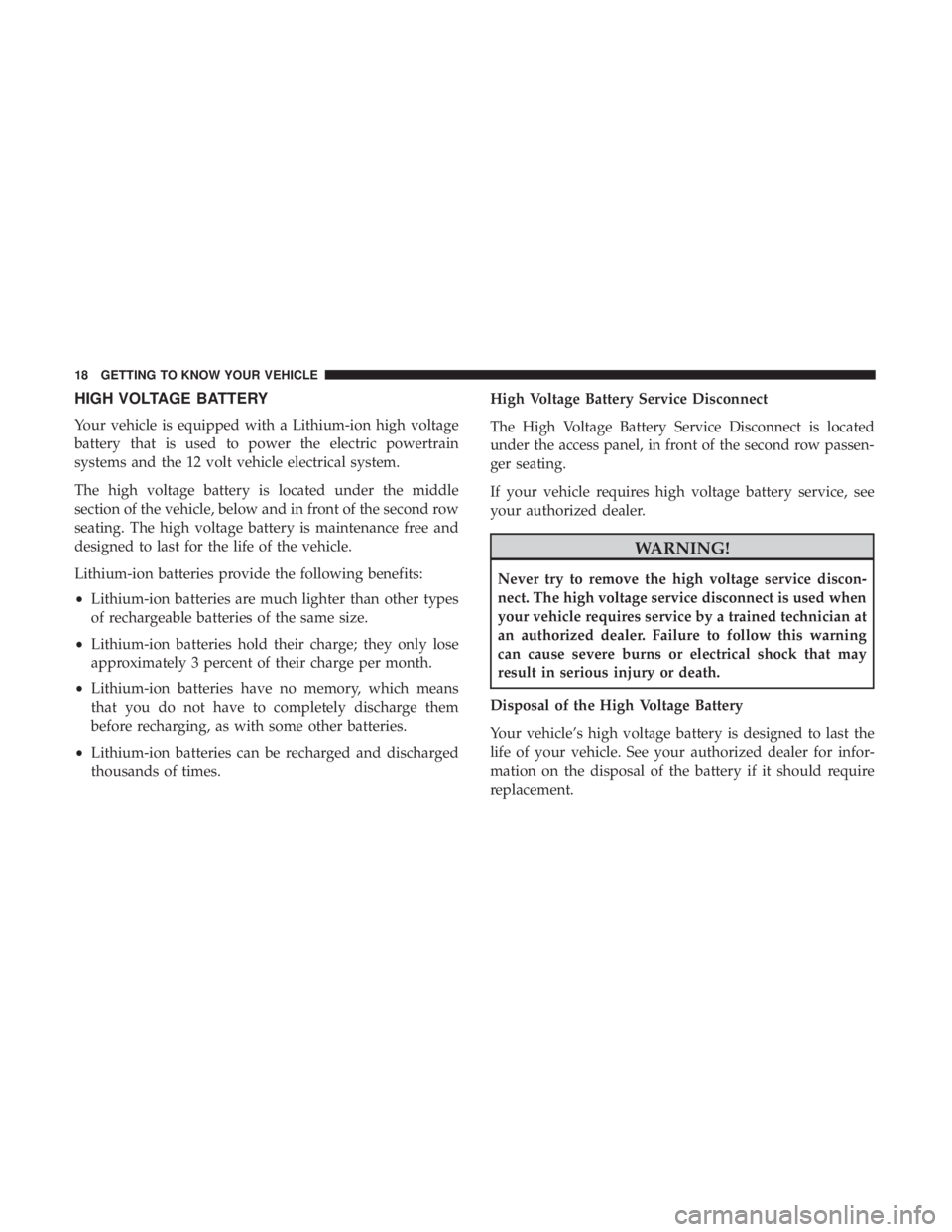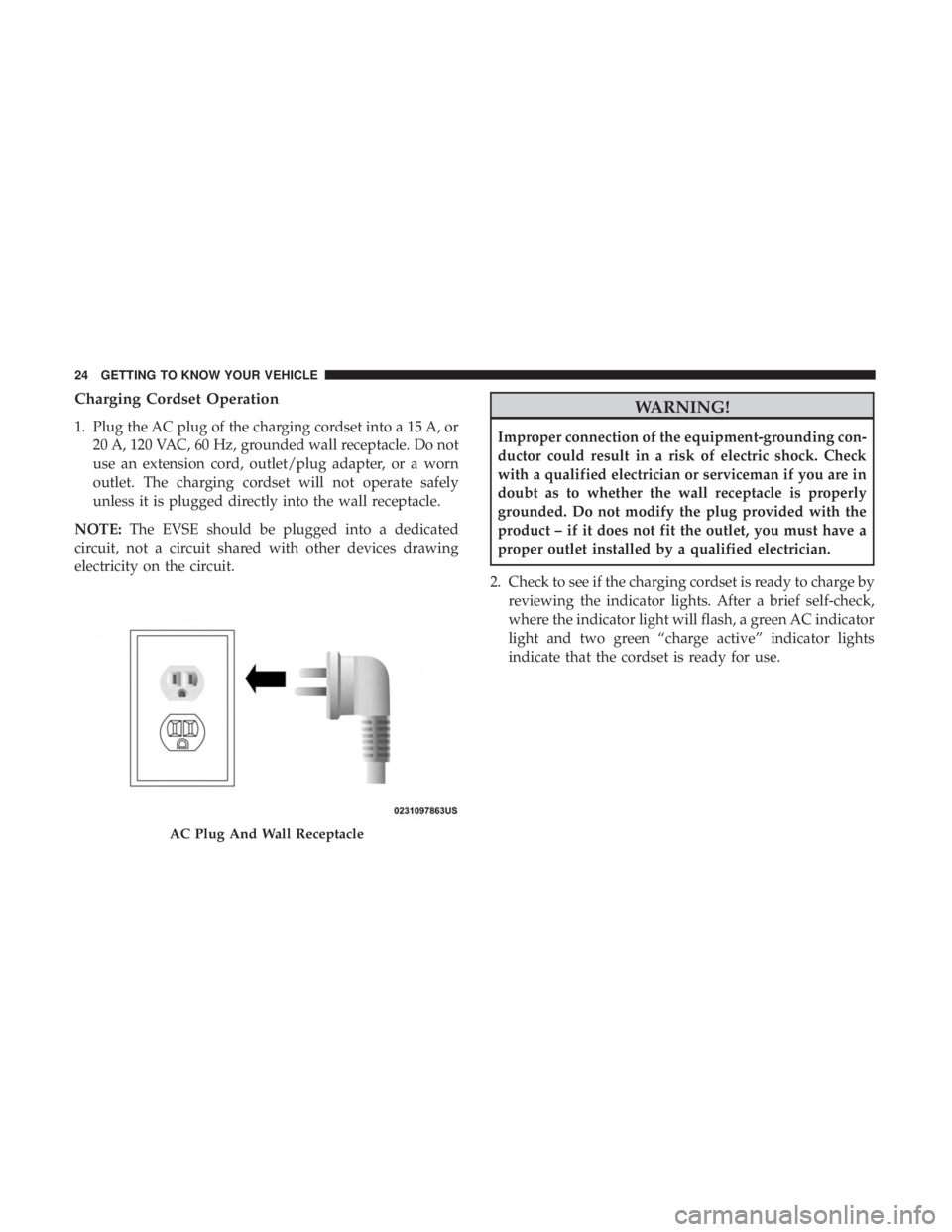Page 10 of 614
FRONT VIEW
Front View
1 — Hood/Engine Compartment
2 — Headlights
3 — Wheels/Tires
4 — Windshield5 — Charging Port Door
6 — Exterior Mirrors
7 — Doors
8 — Fuel Door
8 GRAPHICAL TABLE OF CONTENTS
Page 15 of 614

GETTING TO KNOW YOUR VEHICLE
CONTENTS
�HIGH VOLTAGE BATTERY ..................18
� HIGH VOLTAGE CHARGING OPERATION ......20
▫ SAE J1772 Charging Inlet ..................20
▫ AC Level 1 Charging (120V, 15 Amp) ..........21
▫ AC Level 2 Charging (240V, 30 Amp) ..........31
▫ Charging Times .........................32
▫ Vehicle Charge Indicators ..................33
▫ Hybrid Electric Pages .....................35
� KEYS .................................38
▫ KeyFob..............................38
� IGNITION SWITCH .......................46
� REMOTE STARTING SYSTEM — IF EQUIPPED . . .49
▫ Remote Start Cancel Message — If Equipped ....50
▫ How To Use Remote Start ..................50 ▫
To Enter Remote Start Mode ................51
▫ To Exit Remote Start Mode Without Driving
The Vehicle ...........................51
▫ To Exit Remote Start Mode And Drive
The Vehicle ............................51
▫ Remote Start Comfort Systems — If Equipped . . .51
▫ Remote Start Windshield Wiper De–Icer Activation
— If Equipped ..........................52
▫ General Information .....................52
� SENTRY KEY ............................52
▫ Customer Key Programming ...............53
▫ Replacement Keys .......................53
▫ General Information .....................53
� VEHICLE SECURITY ALARM — IF EQUIPPED . . .53
▫ Rearming Of The System ..................543
Page 20 of 614

HIGH VOLTAGE BATTERY
Your vehicle is equipped with a Lithium-ion high voltage
battery that is used to power the electric powertrain
systems and the 12 volt vehicle electrical system.
The high voltage battery is located under the middle
section of the vehicle, below and in front of the second row
seating. The high voltage battery is maintenance free and
designed to last for the life of the vehicle.
Lithium-ion batteries provide the following benefits:
•Lithium-ion batteries are much lighter than other types
of rechargeable batteries of the same size.
• Lithium-ion batteries hold their charge; they only lose
approximately 3 percent of their charge per month.
• Lithium-ion batteries have no memory, which means
that you do not have to completely discharge them
before recharging, as with some other batteries.
• Lithium-ion batteries can be recharged and discharged
thousands of times. High Voltage Battery Service Disconnect
The High Voltage Battery Service Disconnect is located
under the access panel, in front of the second row passen-
ger seating.
If your vehicle requires high voltage battery service, see
your authorized dealer.
WARNING!
Never try to remove the high voltage service discon-
nect. The high voltage service disconnect is used when
your vehicle requires service by a trained technician at
an authorized dealer. Failure to follow this warning
can cause severe burns or electrical shock that may
result in serious injury or death.
Disposal of the High Voltage Battery
Your vehicle’s high voltage battery is designed to last the
life of your vehicle. See your authorized dealer for infor-
mation on the disposal of the battery if it should require
replacement.
18 GETTING TO KNOW YOUR VEHICLE
Page 22 of 614
•It is recommended that the vehicle be plugged-in over
night where possible to maximize the electric range of
the vehicle.
The message will only be displayed when the ignition is in
the RUN position, or if there was a failed attempt to
achieve PSA (Propulsion System Available) when the High
Voltage Battery cell temperatures are either too cold, or too
hot.HIGH VOLTAGE CHARGING OPERATION
SAE J1772 Charging Inlet
Your vehicle uses an industry standard SAE J1772 charge
inlet (vehicle charge inlet) for both AC Level 1 (120V) and
AC Level 2 (240V) charging.
Battery Conditioning Instrument Cluster Display Message
Vehicle Charge Inlet
20 GETTING TO KNOW YOUR VEHICLE
Page 23 of 614
AC Level 1 Charging (120V, 15 Amp)
Your vehicle is equipped with a 120 Volt AC, SAE J1772
Level 1 Electric Vehicle Supply Equipment (EVSE), also
referred to as a charging cord set. AC Level 1 charging
requires a conventional NEMA 5-15 120 Volt AC grounded
wall receptacle along with the portable charging cord set
provided with the vehicle.
WARNING!
Shock, fire, property damage, or personal injury may
occur if the Portable EVSE Cordset is not used prop-
erly. There are no serviceable parts contained in the
Portable EVSE Cordset. Any attempt to service it may
result in shock, fire, property damage, or personal
injury.
To access the portable charging cord set, open the door of
the cargo area storage bin, on the driver ’s side, and remove
the charging cord set from the storage bag.
NOTE: After use, the EVSE should be placed in the carrier
bag and put back to the cargo area storage bin.
Portable Charging Cord Set (EVSE)
3
GETTING TO KNOW YOUR VEHICLE 21
Page 24 of 614

NOTE:The portable charging cord set is used for AC
Level 1 charging only.
WARNING!
• Read all the instructions before using this product.
• Do not put fingers or objects into the Charge Con-
nector.
• Do not use this product if the flexible power cord or
Electric Vehicle (EV) Cable is frayed, broken, has
cracked insulation or any other signs of damage.
(Continued)
WARNING! (Continued)
•Do not use this product if the enclosure or the
Charge Connector is broken, cracked, open, or shows
any other indication of damage.
• Do not use Portable EVSE Cordset with an extension
cord. Use of an extension cord may cause burns, fire,
or other damage or injury.
• This device may attempt to reset and run after an
interruption.
• There are no user serviceable parts inside the AC
Mode 2 Charging cord set. Do not attempt to repair or
service the charging cord set yourself – personal
injury may result.
• When using a charging station with the charging
cable attached, ensure the cable is not visibly dam-
aged before plugging into the vehicle.
• Do not allow children to operate this device. Adult
supervision is mandatory when children are in prox-
imity to a charge station that is in use.
• Do not use a charge station or vehicle receptacle that
is work or damaged with the AC Mode 3 charging
cable. Plugging into worn or damaged receptacles
may cause damage to the EVSE and vehicle.
(Continued)
Cargo Area Storage Bin
22 GETTING TO KNOW YOUR VEHICLE
Page 25 of 614
WARNING!(Continued)
•Ensure that the EVSEs are always stored in a safe
place. Do not expose them to rain or wet conditions.
Avoid pouring or dipping water or other liquids over
them. If water penetrates the electrical device, the
risk or electrical shock increases. Ensure that all
plugs and cables are free of moisture before using
the EVSEs.
EVSE Charging Cord Set
The EVSE charging cord set is compliant with SAE J1772,
and applicable for use with vehicles fitted with the stan-
dard SAE J1772 charge inlets. The EVSE includes:
• A Charge Connector
• A NEMA 6 rated enclosure with a charge current inter-
rupt device (CCID) with status indicator display
•
An AC Power Cord with NEMA 5–15p, Right Angle plug
• An indoor/outdoor charge cable, EV- rated
• A Status Indicator Display
Charging Cord Set
1 — Charge Connector
2 — Status Indicator Display
3 — Charging Cord Set Enclo-
sure4—ChargeCable
5 — AC Plug
3
GETTING TO KNOW YOUR VEHICLE 23
Page 26 of 614

Charging Cordset Operation
1. Plug the AC plug of the charging cordset into a 15 A, or20 A, 120 VAC, 60 Hz, grounded wall receptacle. Do not
use an extension cord, outlet/plug adapter, or a worn
outlet. The charging cordset will not operate safely
unless it is plugged directly into the wall receptacle.
NOTE: The EVSE should be plugged into a dedicated
circuit, not a circuit shared with other devices drawing
electricity on the circuit.
WARNING!
Improper connection of the equipment-grounding con-
ductor could result in a risk of electric shock. Check
with a qualified electrician or serviceman if you are in
doubt as to whether the wall receptacle is properly
grounded. Do not modify the plug provided with the
product – if it does not fit the outlet, you must have a
proper outlet installed by a qualified electrician.
2. Check to see if the charging cordset is ready to charge by reviewing the indicator lights. After a brief self-check,
where the indicator light will flash, a green AC indicator
light and two green “charge active” indicator lights
indicate that the cordset is ready for use.
AC Plug And Wall Receptacle
24 GETTING TO KNOW YOUR VEHICLE